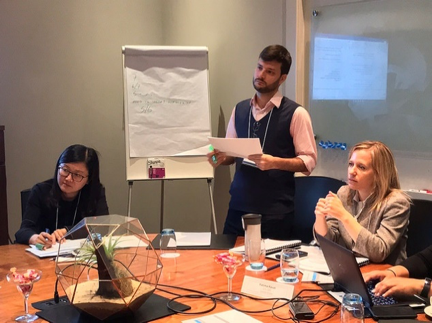Staged Development Tool Training: Prioritizing Public Health Needs to Lessen Diseases and Save Lives
On April 24-26, 2018, IANPHI and the U.S. CDC hosted the first Staged Development Tool training in Johannesburg, South Africa. The SDT training brought more than 20 public health professionals from around the world together to learn how to use the toolkit and process within their own institute to strengthen their public health efforts.

National public health institutes (NPHIs) often perform essential public health functions such as detecting and tracking diseases, investigating disease and illness outbreaks, and taking steps to prevent and control diseases and health threats. Often, NPHIs struggle to prioritize public health functions and in low-resource countries this can be even more challenging with scarce resources.
“They all have limited resources but NPHIs need to focus their resources on the biggest problems,” said Shelly Bratton, director of the U.S. CDC’s NPHI Program. “Where can they have the biggest impact? Where is the disease burden the greatest? What is harming people the most? There are always more public health needs than public health programs will have funds for.”
To help NPHIs assess their current capacity to address public health needs and develop a roadmap for achieving greater success, IANPHI,in collaboration with the U.S. Centers for Disease Control and Prevention (CDC), created the Staged Development Tool (SDT). The SDT process and toolkit help NPHIs assess their current abilities and resources for providing public health services, determine which needs and services should be the highest priority, and develop plans that will help them efficiently and effectively provide public health services and address the most important public health needs.

Left to right: Doris Wang, China CDC, Pedro Burger, Oswaldo Cruz Foundation, Brazil and Shelly Bratton, US CDC
On April 24-26, 2018, IANPHI and the U.S. CDC hosted the first SDT training focusing on how to use the toolkit and process within their own institute to strengthen their public health efforts. The training took place in Johannesburg, South Africa with over 20 public health professionals.
The SDT training also provided individuals from different institutes the opportunity to connect and build relationships with each other through shared experiences and common goals. Alongside experienced facilitators from IANPHI and U.S. CDC, participants were able to go through the entire SDT process. Through the training, participants learned the major concepts and practiced applying them to their public health efforts.

Left to right: Ernest Dabire, WHO Democratic Republic of Congo and Sana Tamim, National Institute of Health, Pakistan discussing their capacity needs during the SDT training.
Although this tool is fairly new, the SDT has been implemented in several countries, with many reporting it has strengthened their ability to provide public health services. IANPHI plans to further promote the SDT in NPHIs around the world.
“This tool can help target public health functions related to health security at the Ministry of Health and define functions of the [proposed] NPHI,” said Dr. Ernest Dabire, WHO, Democratic Republic of Congo. “Our goal is to train professionals from our institutes to use this tool, maximizing networking opportunities as well as transforming public health.”